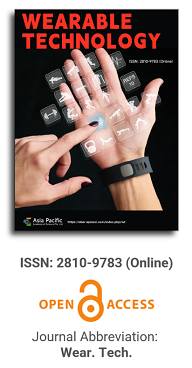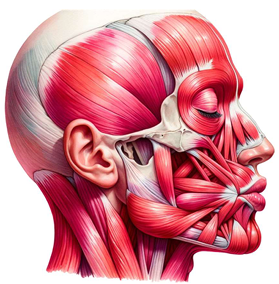

This paper delves deeply into the innovative realm of integrating human emotions with wearable technology. The primary focus is on the conceptualization and development of a kiss transfer device that harnesses the power of wearable technology to bridge the physical gap in human-human interactions. By investigating the intricate nuances of the human-human kissing process, the research seeks to replicate this intimate gesture through a technological medium. The paper not only elaborates on the anatomy, evolution, and hormonal dynamics of kissing but also underscores the transformative potential of wearable technology in capturing and transmitting these intimate moments. This exploration opens up new horizons for long-distance relationships, offering a tangible touchpoint that goes beyond traditional communication methods. Through this pioneering work, the research positions wearable technology as not just a tool for communication but as an extension of our human emotions and expressions.

Deep learning-based discriminant model for wearable sensing gait pattern
Vol 1, Issue 1, 2020
Download PDF
Abstract
In order to effectively improve the accuracy of identifying the gait pattern of wearable sensing data, this paper proposes a new model for deep learning gait mode discrimination that integrates convolutional neural network and long short-term memory neural network, which makes full use of the convolutional neural network to obtain the most local spatial characteristics of data and the long short-term memory neural network to obtain the inherent characteristics of the data, and effectively excavates the hidden high-dimensional, nonlinear, time-space gait characteristics of random wearable sensing timing gait data that are closely related to gait pattern changes, to improve the classification performance of gait mode. The effectiveness of the proposed model in this paper is evaluated using the HAR dataset from University of California UCI database. The experiment results showed that the proposed model in this paper can effectively obtain the time-space gait characteristics embedded in the wearable sensor gait data, and the classification accuracy can reach 91.45%, the precision rate 91.54%, and the recall rate 91.53%, and the classification performance is significantly better than that of the traditional machine learning model, which provides a new solution for accurately identifying the gait mode of wearable sensor data.
Keywords
References
- Alemayoh TT, Lee JH, Okamoto S (editors). Deep learning based real-time daily human activity recognition and its implementation in a smartphone.16th International Conference on Ubiquitous Robots (UR); 2019 June 24-27; Jeju. IEEE; 2019. pp. 179–182.
- Prince J, Arora S, de Vos M. Big data in Parkinson’s disease: Using smartphones to remotely detect longitudinal disease phenotypes. Physiological Measurement 2018; 39(4): 044005.
- Thapar D, Jaswal G, Nigam A, et al. Gait metric learning siamese network exploiting dual of spatio-temporal 3D-CNN intra and LSTM based inter gait-cycle-segment features. Pattern Recognition Letters 2019; 125: 646–653.
- Seyfioğlu MS, Gürbüz SZ, Özbayoğlu AM, et al. (editors) Deep learning of micro-Doppler features for aided and unaided gait recognition. IEEE Radar Conference; 2017 May 8-12; Seattle. IEEE; 2017. pp. 1125–1130.
- Sprager S, Juric MB. Inertial sensor-based gait recognition: A review. Sensors 2015; 15(9): 22089–22127.
- Watanabe Y (editor). Influence of holding smart phone for acceleration-based gait authentication. Proceedings of the Fifth International Conference on Emerging Security Technologies; 2014 Sept 10-12; Spain. Alcala de Henares; 2014. pp. 30–33.
- Choi S, Youn IH, LeMay R, et al. (editors). Biometric gait recognition based on wireless acceleration sensor using k-nearest neighbor classification. Proceedings of the 2014 International Conference on Computing, Networking and Communications (ICNC); 2014 Feb 3-6; Honolulu. IEEE; 2014. pp. 1091–1095.
- Bao L, Intille SS (editors). Activity recognition from user-annotated acceleration data. Second International Conference on Pervasive Computing; 2004 April 18-23; Linz/Vienna. Springer; 2004. pp. 1–17.
- Tahafchi P, Judy JW (editors). Freezing-of-gait detection using wearable sensor technology and Possibilistic K-nearestneighbor algorithm. 41st Annual International Conference of the IEEE Engineering in Medicine and Biology Society (EMBC); 2019 July 23-27; Berlin. IEEE; 2019. PP. 4246–4249.
- Nickel C, Brandt H, Busch C (editors). Benchmarking the performance of SVMs and HMMs for accelerometer-based biometric gait recognition. International Symposium on Signal Processing and Information Technology (ISSPIT); 2011 Dec 14-17; Bilbao. IEEE; 2011. pp. 281–286.
- Nickel C, Wirtl T, Busch C (editors). Authentication of smartphone users based on the way they walk using k-NN algorithm. Eighth International Conference on Intelligent Information Hiding and Multimedia Signal Processing; 2012 July 18-20; Piraeus. IEEE; 2012. pp. 16–20.
- Zou Q, Wang Y, Zhao Y, et al. Deep learning based gait recognition using smartphones in the wild. IEEE Transaction on Information Forensics and Security 2020; 15: 3197–3212.
- Ding Z, Yang CF, Xing K, et al. (editors). The real time gait phase detection based on long short-term memory. IEEE Third International Conference on Data Science in Cyberspace (DSC); 2018 June 18-21; Guangzhou. IEEE; 2018. pp. 33–38.
- Anguita D, Ghio A, Oneto L, et al. (editors). A public domain dataset for human activity recognition using smartphones. Proceedings of the 2013 European Symposium on Artificial Neural Networks; 2013 April 24-26; Bruges; 2013. pp. 437–442.
- Krizhevsky A, Sutskever I, Hinton GE (editors). ImageNet classification with deep convolutional neural networks. Proceedings of the 25th International Conference on Neural Information Processing Systems; 2012 Dec 3-6; Lake Tahoe. Advances in Neural Information Processing System; 2012. pp. 1097–1105.
- Mazilu S, Hardegger M, Zhu Z, et al. (editors). Online detection of freezing of gait with smartphones and machine learning techniques. 6th International Conference on Pervasive Computing Technologies for Healthcare (PervasiveHealth) and Workshops; 2012 May 221–224; San Diego. IEEE; 2012. pp. 123– 130.
- Scherer D, Muller A, Behnke S (editors). Evaluation of pooling operations in convolutional architectures for object recognition. 20th International Conference on Artificial Neural Networks; 2010 Sept 15-18; Thessaloniki. Springer; 2010. pp. 92–101.
- Wang C, Yang HJ, Bartz C, et al. (editors). Image captioning with deep bidirectional LSTMs. Proceedings of the 24th ACM International Conference on Multimedia; 2016 Oct 15-19; Amsterdam. 2016. 988–997.
- Gers FA, Schraudolph NN, Schmidhuber J. Learning precise timing with LSTM recurrent networks. The Journal of Machine Learning Research 2003; 3: 115–143.
- Fernandez-Lopez P, Liu-Jimenez J, Kiyokawa K, et al. Recurrent neural network for inertial gait user recognition in smartphones. Sensors 2019; 19(18): 4054.
- Jun K, Lee Y, Lee S, et al. Pathological gait classification using Kinect v2 and gated recurrent neural networks. IEEE Access 2020; 8: 139881–139891.
Supporting Agencies
Copyright (c) 2020 Jianning Wu, Qiaoling Tan

This work is licensed under a Creative Commons Attribution 4.0 International License.

Prof. Zhen Cao
College of Information Science & Electronic Engineering, Zhejiang University
China, China
Processing Speed
-
-
-
- <5 days from submission to initial review decision;
- 62% acceptance rate
-
-
Asia Pacific Academy of Science Pte. Ltd. (APACSCI) specializes in international journal publishing. APACSCI adopts the open access publishing model and provides an important communication bridge for academic groups whose interest fields include engineering, technology, medicine, computer, mathematics, agriculture and forestry, and environment.





